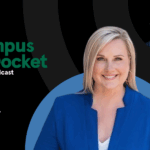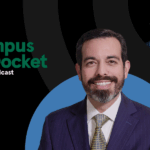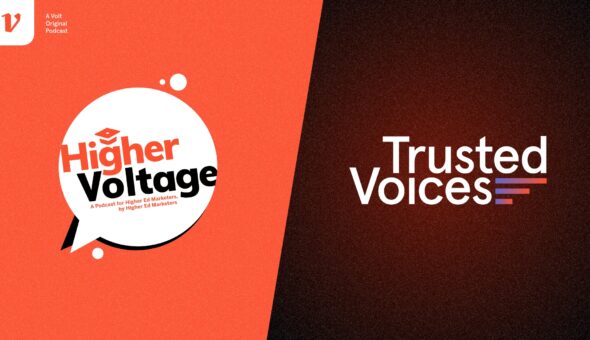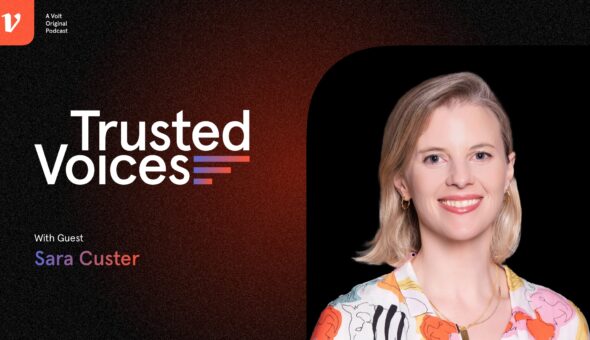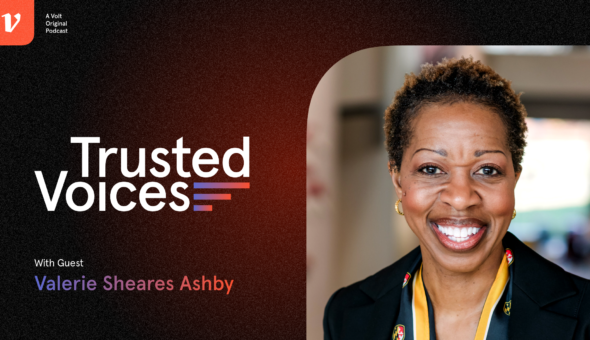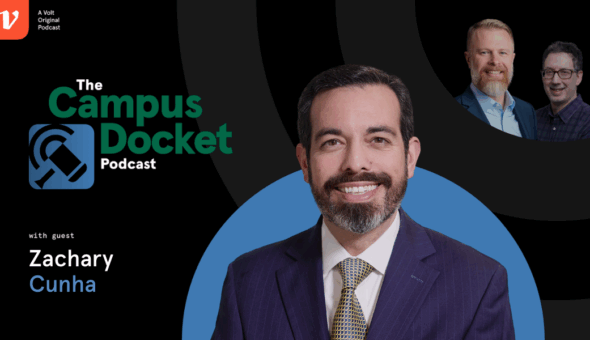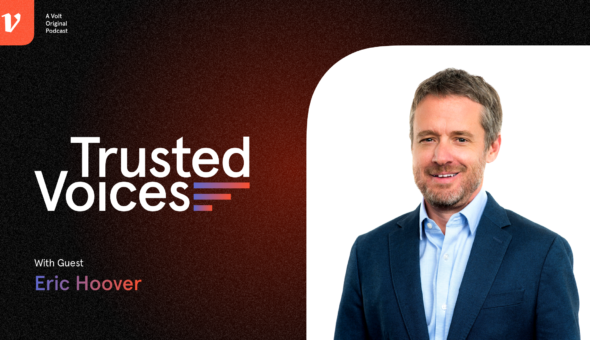Read the full transcript here
Teresa Valerio Parrot
Hello, Happy New Year and welcome to the Trusted Voices Podcast. I’m Teresa Valerio Parrot alongside Erin Hennessy, and in each episode we discuss the latest news and the biggest issues facing higher education leaders through a communications lens. For these conversations, we’re often joined by a guest who shares their own experiences and perspectives, but we also make time for one on one conversations to talk about what we’re seeing, hearing and thinking.
Erin Hennessy
Hi.
Teresa Valerio Parrot
Hi. Happy New Year!
Erin Hennessy
Happy New Year to you. 2025.
Teresa Valerio Parrot
Yes, 2025! Since this is a podcast, you can’t see I am wearing Happy New Year 2025, a little headband with some…some ears going here.
Erin Hennessy
Do you not call those beelie boppers?
Teresa Valerio Parrot
Uh, in the West I don’t think we do. No.
Erin Hennessy
Okay. It could be an East Coast thing.
Teresa Valerio Parrot
Yeah…
Erin Hennessy
Pop quiz. Do you know what day of the week it is? Because I sure don’t.
Teresa Valerio Parrot
I keep saying today’s Monday, but it’s actually Thursday. I told my husband, “make sure you put out the trash and the recycling.” He reminded me, today’s Thursday.
Erin Hennessy
Yes, it’s very confusing after a really nice long break of not knowing what day it was and not really needing to. It’s very strange. But as I said to some of our team this morning, this is where the four day work week really shines. Because I have one day of work. You have one and a half days of work, and then we are blessedly back on a weekend so.
Teresa Valerio Parrot
And then next week I will figure out when Monday is.
Erin Hennessy
And then the week after that, we have a short week, again because of the Martin Luther King Jr. holiday.
Teresa Valerio Parrot
We’re gonna get this figured out.
Erin Hennessy
By February, for sure.
Teresa Valerio Parrot
And then we have Presidents Day. So it all works out.
Erin Hennessy
Oh, man, okay, cool.
Teresa Valerio Parrot
Okay, so today we are talking about what we see on the horizon for this year.
Erin Hennessy
Yes, and it’s all unicorn giggles and rainbows, as far as I can tell.
Teresa Valerio Parrot
And headbands that say Happy New Year.
Erin Hennessy
And headbands that say Happy New Year. We have already sort of commented this morning offline about how much news has happened in the last 10 days. But also, let’s, today’s the second, how much news has happened in just the last two days? And I don’t, I don’t care for this pace. I really don’t care for it at all.
Teresa Valerio Parrot
Well, and I think it’s important for us to say that because we’re pulling out our crystal ball, mine’s very cloudy because I am not doing well on my football bowl predictions. So as we talk about how well we’re predicting the future, good luck with what we’re about to say. So here we go.
Erin Hennessy
Yeah, there was a lot of football news over the weekend, most of which I ignored, but I do think…
Teresa Valerio Parrot
And almost all of which I got wrong.
Erin Hennessy
I…okay well that’s, I mean, there are, here comes some blasphemy, more important things to be wrong or right about. But the one story I did manage to catch is the postponement of the Sugar Bowl, obviously, in the wake of events in New Orleans very early on New Year’s Day. And then somebody yelled at somebody else, which I realized could apply to almost every other football game that happened.
Teresa Valerio Parrot
Every other football game, every probably family event that happened, a whole bunch of things in society. Yeah, that kind of sums up all of the end of 2024 and a lot of the beginning of 2025. With that, yeah, let’s dive into what’s going on in higher ed.
Erin Hennessy
Why don’t you talk about some athletics? Because, you know, that’s where I just nod and go, “mhm yes, yes, I agree.”
Teresa Valerio Parrot
Well there was breaking news yesterday in higher education, and higher education is one of the five topics I wanted to talk about. There’s a lot going on in higher ed. Yesterday, Dartmouth basketball players ended their unionization attempt, and there’s real reasons for that. They anticipate a shift in the NLRB, and how friendly it might be to the request with the Trump administration, so they decided to pull back on that. And that’s really fascinating, because they were really gaining steam on the attempts to unionize. So that really shifts what we’re talking about with unionization, but we’re still seeing so much traction with pay for play, NIL is still going strong, and we’re still seeing traction on House v. NCAA, so there’s still so much going on as we talk about athletics, and as I talk about the work that I’m doing with campuses right now, we’re still seeing so many campuses that are really in the Division I space, having frank conversations among their presidents and their boards and saying, can we afford to participate at the Division I level? What does this mean for us? And can we invest in this way? Can we participate for Division I at the way that we would want to and can we also invest and participate and be in compliance with Title IX? So there are some really great governance conversations that are going on across this country.
Erin Hennessy
How many years do you think it’ll be before we see, to your point, a shakeout is coming at a lot of institutions that were sort of cuspy in terms of really fighting to stay in Division I, really spending a, this is a technical term, crap-ton of money to do it are going to shake out. And either, I don’t want to say fall, because that puts a value, but shift to a Division II approach to athletics, or will we see sort of another junior division, one sort of structure in place. How long do you think it’ll be before we can look back and say, okay, now we’ve really seen the impact of NIL, of these kinds of shifts in athletics, and be able to say, like, oh, okay, so this is what the impact is.
Teresa Valerio Parrot
So I think those conversations, for a number of institutions, started this past year. I think the public conversations are going to begin now in 2025 and I think that for the boards, instead of talking about the way that you initially framed that, what I would say, and this is how I’m discussing this with presidents and boards, is that the mission focused institutions that are saying, where are we investing our dollars? And they don’t have the kind of money that they would want to put towards athletics like they’ve wanted, and also invest in all of the ways that they want to invest in the key components of their institutions. This is the year that they have to have those tough conversations if they haven’t already been doing that, and if they aren’t going to stay Division I, there is going to be a scramble among institutions to decide what they do and where they go. So this is the year if they haven’t already been having those conversations. This is the year that some will be catching up to those that already have been having those conversations, and this is the year of movement, and next year is the year of catch up for those that haven’t been having those conversations. So 2025 is a big year as we talk about Division I, realignment and reprioritization. It’s going to be a big year.
Erin Hennessy
Might be time to reach out to Amy Perko and see if she wants to come back and talk to us some more. If folks haven’t listened to that episode from gosh, all the way back in season one, our conversation with Amy Perko of the Knight Commission, that’s well worth jumping back there to see sort of how far we’ve come and what hasn’t changed at all.
Teresa Valerio Parrot
Yeah, and one last note I would put on that one is that I have been really stressing with a number of institutions, Division III is not…that’s not a dirty phrase. Division III is fantastic athletics. We need to move away from thinking that Division I is the end all to be all. Division III is fantastic sport. It really has some amazing benefits, and for a number of institutions that is so strongly aligned with who they are and what they provide to their campus experience, that we need to break this mental block that so many institutions have that it’s less than. It is not. So for those institutions that think that it is Division I or nothing, please, please really look into what Division II and Division III offer, because that is really in your head. Please look into what other options are out there, if that’s what that you think it’s all or nothing.
Erin Hennessy
Yeah. And I would encourage our journalist friends who are covering this issue to look at their language very carefully when they write about upcoming shifts, and to not make the slight mistake there that I almost made and put language of value and judgment on shifts between conferences. We’ve all seen the headlines of “drops” and “retreats” and “exits,” and just being thoughtful about those words would be helpful.
Teresa Valerio Parrot
And instead really focus on mission alignment. Okay, Erin, what’s on your mind?
Erin Hennessy
So one of the things that I’m thinking about, and it came up a little bit there when you talked about NLRB, is just the fact that we are going to be entering into a period of transition between administrations in the next couple of weeks, and what that is going to mean for higher education. And we saw that President Biden, over holiday break, signed a stop hazing bill, legislation that is going to impose some additional federal reporting requirements on institutions so that they are being public about hazing incidences on their campus, as well as putting in place other requirements that institutions need to be thoughtful about related to hazing. But when you talk about NLRB, when we talk about the Biden administration withdrawing some proposals around student debt relief because of the upcoming change in the administration, keeping in mind what your institutional calendar is for reviewing your policies, procedures, making sure that we are in alignment as new things come down the pike, I think is going to be very, very important on our year ahead checklist. There was also a piece in Higher Ed Dive this morning, which I will admit the headline did its job. I haven’t clicked on it yet, but the headline stuck with me, talking about whether or not the Department of Education needs a rebrand, which is fascinating heading into a new administration and a new Department of Ed headed by Linda McMahon, which I think everyone is sort of eager to see what that’s going to mean for the industry, and we’ll be watching what our association colleagues in Washington have to offer about likely policy directions and regulatory directions, as well.
Teresa Valerio Parrot
As I thought about the politicalization of higher education, I kind of thought of that on four fronts. I agree with you on campus culture. I think that is going to be tremendously important to think about. What is this going to mean we don’t live in a bubble, so whatever is happening at the national and the state level that’s going to be bubbling up on our campuses, and as you mentioned, this hazing bill, I think is going to be tremendously important for us to be thinking about, but also the ecosystems that we live in and how those impact our own campuses are going to be tremendously important. I also was thinking about this accreditation ecosystem, also that we’re talking about. If you haven’t listened to our episode with Belle Wheelan, I’m tremendously proud of that, and I encourage people to go back and listen to that, because how President-elect Trump is talking about accreditation, how she and other accreditors are thinking about what might happen with accreditation across this country, how some of these leadership positions and roles and entities are thinking about what comes next in higher education is incredibly important. I’m thinking about, as you are and you just mentioned the Department of Education, and what happens with that department and the very important role that they play. I thought it was interesting with the passing of Jimmy Carter and talking about the history and the legacy of the Department of Education, what its role was, and how he envisioned what the Department of Education should be doing, and what it has been doing, to think about where we’re moving next with the Department of Education, there is a real role that it plays, and how it can be reimagined, or what role it should play, is really important for us to be thinking about so as we think about. So as we think about the Department of Education, as we think about not just what a state’s role is for higher education, but also what the federal responsibilities should be for education, it’s really important for us to think about where we’ve been. And we also need to be thinking about what that state’s role is, and if we do start to have have and have nots across this country based on state legislatures. So we have been spending so much time thinking about what happens at the federal level, and I don’t want for any of us not to be thinking about what happens at the state level, and also as specific states start to copy what is happening with other states, whether it’s Florida or Texas or some of the other states, we could quickly start to have haves and have nots across this country. So thinking about, again campus cultures, accreditors, Department of Education and state legislatures, we have a lot going on when we talk about politicalization of higher education.
Erin Hennessy
Absolutely, and this is the poli-sci major in me, it’s going to be fascinating to see Trump come in for this new term where he is effectively already a lame duck. Can’t run again.
Teresa Valerio Parrot
In theory.
Erin Hennessy
In theory. The way that the Constitution is currently written, he is prevented from running for…
Teresa Valerio Parrot
Well and read and read.
Erin Hennessy
Yes, and thinking about the fact that even though he’s got the control of the House and Senate right now looks like the House is starting to implode again over leadership elections. So who knows what’s going to happen there? My larger point being the gridlock that has marked Washington for years and years and years, see Belle Wheelan’s comments about renewing the Higher Education Act, means that most of the action will be at the state level in terms of sizable, meaningful shifts, policy-wise, sort of culture-wise, and keeping in mind that today’s January 2, as we record this in a lot of states, yesterday, new laws went into effect. And so we will start to see what these things look like as the rubber hits the road in each of these states, and to your point, as you see things get copied and as organizations like ALEC and other places take sample legislation and push it out to states where they feel like leadership might be receptive to some more conservative shifts. Like I said, I’m not, I’m not down with this pace, at this point, my little stress level needle is inching up already.
Teresa Valerio Parrot
Right, right? So I’m going to add a little bit more anxiety there for you. Here we go.
Erin Hennessy
Fantastic.
Teresa Valerio Parrot
My third topic that I’m watching is enrollment trends, and I’m going to have this all, I keep talking about this, I’ve been previewing it because I was so excited for it to come out, and last month, WICHE’s Knocking at the College Door, the new edition, the 11th edition, came out. And here’s a 2025 data point for you: the total number of high school graduates is expected to peak in 2025 and then decline steadily through 2041. So here we go. The proportion of future public high school graduating classes who come from underrepresented racial and ethnic backgrounds, particularly Hispanic and multiracial graduates, will continue to increase. So we need to be thinking about what we’re doing to attract these students, especially as we have continually declining high school graduates. What does this mean for all of us?
Erin Hennessy
Yes, attract and support and welcome, and…yeah.
Teresa Valerio Parrot
So I think this is our future. This is what we need to be focused on. And what are we doing about that? We are now to the point where everybody is saying we’re beyond the enrollment cliff. So we’re no longer to the point of the cliff we have now jumped.
Erin Hennessy
The one thing that I’ll try and reframe a little bit and that I appreciated about the reporting when this came out last month, is that a number of folks that you and I know and like and respect really emphasize the fact that it’s not so much a cliff, it is a long slide.
Teresa Valerio Parrot
Correct.
Erin Hennessy
And that it is, as you said, steadily declining. So it isn’t like we’re pulling some Wiley Coyote stuff here and going right over a cliff. It is a long slide. So I’m hoping that change in language helps some folks who may have been paralyzed by the cliff imagery and language to realize this is something that can be managed, can be addressed. You’ve got to be quick and strategic and thoughtful and start now. But I do think it’s really interesting to see more specificity come out in these numbers and the context and the sort of granularity of what’s in that report, and I think everybody should be clicking and downloading that, because there’s going to be a lot of information in there that I think can help inform cabinet and board discussions as we get into, really, we’re almost halfway through this year’s recruitment cycle.
Teresa Valerio Parrot
Agreed. I think there was another piece there that was a reminder of less than a cliff, and that is the COVID-19’s impact on the education pipeline is modest. So I think that was good. People were worried about it being more than modest. And then the second piece that I think, the third piece, I should say, that is a reminder that this isn’t dire, but it needs to be taken seriously, is that we need to also be looking at workforce needs. So as we look at that decline and that steady decline, there is some opportunity there that if we look at workforce needs, that allows us to bring some of that back up. So everything isn’t the worst, but we need to be very realistic about how we’re looking at this and how we’re framing solutions for the future.
Erin Hennessy
Yeah, everything isn’t the worst yet.
Teresa Valerio Parrot
Yeah, everything isn’t the worst yet.
Erin Hennessy
And because we’re referring people all kinds of places in this episode, and you bring up workforce, another opportunity to share a resource, which is Paul Fain’s, great newsletter The Job which, if you aren’t subscribed to you should be, so that you can be thinking smartly about how workforce intersects with higher ed and all of the work we have to do to be a more responsive industry as we move forward through the year.
Teresa Valerio Parrot
Agreed.
EK ad read
Erin Hennessy
Looking at trends, talking about trends, talking about federal oversight and regulation. You and I texted just at the very beginning of break when the Department of Education dropped their latest set of financial responsibility scores, they dropped two years, the last two academic years, which had been, I believe they gave institutions a bit of a delay to file all of that data because of the lingering aftereffects of COVID-19. And I will just say that it’s probably one of the more obscure metrics for people out there who aren’t as steeped in federal policy as those of us who really follow the industry, but it’s a really interesting set of data that essentially scores institutions on their financial responsibility and sustainability from a negative one to a three, and imposes a set of sanctions on institutions that are not living up to what the department defines as financial responsibility. And I’ll note here that all metrics are limited in any number of ways, and there are smarter people than me who can talk about what those limitations are, but it’s really sobering to look at that data and to think about any number of policy and news intersections that are happening. We have talked so many times on this little program about the Cares Act funds that were pushed to institutions during the pandemic, and the way in which that helped a lot of institutions that were again cuspy, in terms of financial strength, kick that can down the road. And those funds have expired. They have been spent. Some of them have been clawed back, whatever it is, and we are now really starting to see again, rubber hitting road from a personal angle, I popped in there and looked at one of my alma maters, and you got the text message from me that included at least a profanity or two…
Teresa Valerio Parrot
Or three.
Erin Hennessy
…or three and some all caps, maybe. And that also led me to do a little searching. And the financial responsibility scores are connected to heightened cash monitoring sanctions from the Department of Education. So all to say, friends on our campuses, it’s worth jumping into that data set, which we’ll link in the show notes, just to see where your institution is, where it’s been over the past couple of years, so that you can have a conversation with your Chief Business Officer about what this year looks like, what the impact of a good enrollment year might be. A bad enrollment year might be so that you can start getting a vocabulary and a messaging structure together to talk about these things, but also so that you can be part of the team that is pushing for figuring out what the next steps are.
Teresa Valerio Parrot
And I think also there are some families that are looking into these metrics. So when a family comes to you and says, I looked into your institution, what does this mean? Or when a faculty member comes to you and says, I looked into this for our institution, or at a faculty governance meeting, when you’re giving a quarterly report and in a faculty setting group setting, they say, what does this mean? You’re prepared for these questions? Because the reality is, you should be prepared to answer these questions. You should be prepared to say, here’s where we are, here’s how these numbers were derived, and here’s what this means for our future stability. This is part of our jobs.
Erin Hennessy
Yeah, absolutely.
Teresa Valerio Parrot
It doesn’t mean that you’re responsible for how you got there, but you need to be able to answer what it means.
Erin Hennessy
Yes. And for some of these, you know, institutions that are in heightened cash monitoring, there are requirements for things that you need to post on your website and all kinds of things. And sometimes it’s really hard to know what we know about the industry and be an alumn of a place, because it’s challenging to love a place and see it go through some of these really tough decisions and tough conversations. The other thing I’ll say is you and I talk all the time about institutions being thoughtful, boards and leaders. I don’t want to say institutions. Let’s talk about who owns this, presidents and boards being thoughtful about when it is time to make the hardest choice and look for a merger partner, look for an acquisition partner, and consider what we hope will be a responsible shutdown. And that has real impact to the timing of that. Those decisions have real impacts on students, on faculty and on staff, but they also, in so many cases, have real impacts on the communities that host our institutions. We won’t go too far into that, but I do want to call out yet another I feel like we’ve really seen some great journalism from The Chron lately, a piece from the Chronicle about what it means for small towns, in particular when institutions that host them close. It was published in December. It was a great piece. Highly recommend it to folks. So it really is important for our institutions to be smart and responsible, to be transparent about their financial position, even as you are sending alums your requests for end of the year, donations and things like that, or estate bequests, requests for estate bequests, it’s just time that we’ve stopped counting on a silver bullet to show up and really think about how we can be humane and transparent and responsible.
Teresa Valerio Parrot
Well and to your point and to the point of this article, we are so intertwined. When we talk about town-gown relationships, it is really hard to separate the two, and that’s in the best case scenarios and the worst case scenarios. It is really hard for these towns, not just from a real estate perspective, but from utilities and from how small businesses survive, and from all of the ways in which we talk about the good and the bad from a town-gown relationship, because that’s what we have, that’s what we foster. That’s what we say are our selling points, but that’s the reality of what we build. So we need to be thinking about that. And there are ways that we need to be transparent with each other and have that go both ways when we talk about these economic impact studies that we tout, there is something real behind that.
Erin Hennessy
Yeah, and they have names and faces and, you know. This is turning out to be a real cheery episode so far. I’m super jazzed.
Teresa Valerio Parrot
So let’s talk about some other things. I did want to say, we talked quite a bit about leadership, pipelines and hirings. So I have two last items here, because I think they’re intertwined. There were a whole bunch of hirings that we saw over the holidays. And I just want to mention that we talked on our last episode about make sure in the new year that you are thinking about professional development. We saw a whole bunch of hirings, and I just want to mention to people again, if you’re new in a position, make sure that you’re prioritizing professional development. Make sure that you’re thinking about your team and with the new year and resolutions and what you’re thinking about, that you are putting aside time for things like writing. You are putting aside time for professional development opportunities, whatever that looks like. That you are thinking about coaching, not as a negative, but as a positive. So as we think about leadership pipeline, as we think about hirings, as we think about opportunities, this is the time to be saying “and what comes next.” So when you see that announcement, be thinking about and now, what now? Now what happens? How do we think about the future? How can I be planning on the second and whenever this episode comes out next week for the rest of the year. This is a 52 week process, not something that we think about just in December, so I’m raising it again at the beginning of the year, and I want to put something on people’s radar screens. This was something that came out at the end of last year. This is a morale thing, I think, and it’s also a positive. Our good friend Kevin McClure, who was on our podcast at the end of last year, he announced the title of his book and the book cover, and he announced a newsletter. And I want to put that onto people’s radar screens. He has The Caring University that is going to be coming out in July. We’ll put in our show notes his newsletter launch, and I think that’s really important. So he is going to be putting out a newsletter about once a month, and it is going to give an update on his book. He’s going to be talking about a tidbit of something in higher education, and then giving a morale boost. We all need a morale boost. So my suggestion to everybody is sign up for Kevin’s newsletter and get a little bit of a Kevin-ism. He didn’t like that term. I thought that was great. I also gave him a suggestion for a Kevin Kernel. He liked that even less.
Erin Hennessy
Oof!
Teresa Valerio Parrot
You don’t like that, yeah? I gave him a whole bunch of different terms that were worse than Kevin-ism because I hoped that would make him like Kevin-ism more, and it didn’t. So there you go. Sign up for Kevin’s newsletter.
Erin Hennessy
I’m just glad you didn’t call it like a snackerels, which I still don’t believe, is a word.
Teresa Valerio Parrot
Snackerels is a word. I’m going to make that a thing in 2025.
Erin Hennessy
Okay, that sounds like fun.
Teresa Valerio Parrot
Yeah, my 2024 word was grace, and I’m going to keep it for 2025 because I think we’re going to need grace in 2025 as well.
Erin Hennessy
I am going with, I don’t do resolutions…
Teresa Valerio Parrot
I don’t either.
Erin Hennessy
…or themes or any of those kinds of things, but I am going with make generous assumptions, because I think it’s so easy for all of us to sort of demonize and yell about stuff, and I’m just gonna, I’m just gonna make generous assumptions. That person who cut me off in traffic really does have somewhere very, very important to be, and so I’m not going to give him the Jersey salute. I’m just going to let him go. I’m going to make some generous assumptions. The other thing I wanted to just touch on briefly, which isn’t higher ed, but I saw you pop off on this over break, and I agree with every word. Let’s talk about Blake Lively and Justin Baldoni and what crisis communication is and isn’t because I have already bookmarked, if folks haven’t read it, the piece that kicked this whole conversation off was in The New York Times.
Teresa Valerio Parrot
Don’t click on the link. On that link, click on my LinkedIn post instead. Go ahead.
Erin Hennessy
There are a whole bunch of pieces out there now, since the initial thing dropped, and Baldoni is now countersued and blah, blah, blah, but I’ve already marked that piece for conversation with my PR ethics students. When class starts next week, am I ready? No, I’m not. To talk about what PR is and isn’t and what the ethical conduct of our profession is and isn’t, and how aggravating it is when people who have watched Scandal probably too much make assumptions about what public relations and communications is, what crisis communications is, and how poorly served we and our clients are by those assumptions.
Teresa Valerio Parrot
Yes, you got to see me. I went to bed, and I have the benefit of being on Mountain Time Zone. So when I went to bed, you all were fast asleep, but I was already seeing these pieces pop up in social of people talking about this PR consultant and this PR guru who really just did a social media smear campaign, right? That is not PR. Who they were referencing her as a crisis PR consultant. And I went to bed just kind of bubbling, and I woke up early because all night long It just bothered me, and when I woke up in the morning, really early, there were a lot more pieces that were referencing her as such, and I on social just started replying and saying, please do not refer to her as such. This is what I do, and this is not, this is not the work that I do. This is not the work that my colleagues, do we take our profession very seriously. Very seriously. We have a code of ethics. PRSA has a code of ethics. It is a baseline we each can then go from there and take it to higher levels. This is a baseline for us. She is not at the baseline, and what she is doing is not public relations. We talk people into telling the truth, and that is very hard work. It makes people vulnerable. It has people confront truths that they may not want to confront. It has a component of helping people rebuild image and reputation when they are at a low it gets people to address hard truth. That is what we do, and we are proud of our work, and it is hard work, and you and I both lose nights and weekends, and we cry about this. We work with people who cry through really, really bottom points. We do hard work. Like I am getting the chills right now about this. And this woman and this work that is in these documents, the accusations I should say about her work, let me put it that way, that is not crisis and PR work, that is not I just want to say that. And I was so angry, and I was so glad that how I talked about our industry was defended because what we do is hard for us and for our clients. So thank you for raising this, because I am so emotional about this, because I am proud of the work that both of us do. You do amazing work. I do really hard work. I like to think it’s amazing, and what we saw in these pieces is not that.
Erin Hennessy
No, and you and I talk a lot about there are some clients who understand what public relations and communications really is and is about, and that it isn’t papering over or fixing a problem.
Teresa Valerio Parrot
We do not spin.
Erin Hennessy
Right. It’s a process of building and it only works if you actually do the hard work behind it. And then there are folks in our sort of adjacent to our industry, who do more publicity work and that’s…
Teresa Valerio Parrot
Campaign work.
Erin Hennessy
Yeah, it’s not what we do. It is valid. It is done responsibly most of the time. It has a very different end goal. This is so far beyond the pale, it makes our work harder, because we talk about this all the time, and I talk about it often in training, people believe that they are so savvy about communications. And as a generalization, we are much more savvy about communications than we would have been 30, 40, 50 years ago, but people believe that this is an appropriate way to address an issue, and so you and I sit in conference rooms with people who get paychecks with a lot of zeros behind them, and we have to help them understand and see that this isn’t an approach that is going to bring you long term, lasting results, because it isn’t addressing the underlying issue.
Teresa Valerio Parrot
It does not build trust. It does not build relationships. It is not authentic. You and I have walked away from so many potential engagements. We have been fired from engagements willingly. We have said…
Erin Hennessy
With great joy.
Teresa Valerio Parrot
…we will not do this because we are willing to be fired from this engagement, because we are here to help you tell truth, and if you want us to forward a narrative that is not rooted in truth. We are not the agency for you.
Erin Hennessy
Yep, yep.
Teresa Valerio Parrot
Because we have to be able to sleep at night and we have to be able to represent our clients with truth.
Erin Hennessy
Yeah, and the kicker is, it doesn’t work.
Teresa Valerio Parrot
Right.
Erin Hennessy
It doesn’t work. The story’s not over.
Teresa Valerio Parrot
It’s not over.
Erin Hennessy
There all kinds of lawyers and all kinds of consultants and crisis communications experts who are going to make, to be real Frank, a shit ton of money off of this whole situation on both sides. The underlying issue is going to remain the same.
Teresa Valerio Parrot
And underlying truth is going to be the same.
Erin Hennessy
Yeah, whether it gets out there or not.
Teresa Valerio Parrot
It will get out there. You and I both know this.
Erin Hennessy
Eventually.
Teresa Valerio Parrot
Yeah.
Erin Hennessy
Yep.
Teresa Valerio Parrot
We have a client who told us that there can be two truths. And that was one of those where I say I will be getting a flight home early. It was so nice working with you.
Erin Hennessy
Yeah, best of luck. Best of luck. We’ll be rooting for you from over there. Well, I think that’s a pretty good rundown of important things for the beginning of the year.
Teresa Valerio Parrot
Yes. And on that note, here’s what I’ll say, sign up for that newsletter about morale, because we all need a little bit of happiness and joy.
Erin Hennessy
Yes. Also, may I recommend a regular napping schedule. And to close out from last episode, I did not read Robert Caro’s The Power Broker over break, but I did read this absolutely fascinating book about Queen Elizabeth the Second by this great author who sort of does these social biographies, if anybody wants to talk about it, text me.
Teresa Valerio Parrot
I read some really, really good trash fiction and I’m so proud of myself for it.
Erin Hennessy
Okay, good job. I read a very un-cheery book about the murder of Emmett Till so we had very different holidays.
Teresa Valerio Parrot
Mine ended happily ever after, and you learned something. So there you go.
Erin Hennessy
Yeah, I hope that folks are coming back with some renewed energy and passion and patience and…
Teresa Valerio Parrot
…and grace.
Erin Hennessy
And making generous assumptions. We’re excited to be back with you, and we’ll be excited to be in your ears in a couple weeks of another great episode.
Teresa Valerio Parrot
Happy New Year, Erin!
Erin Hennessy
Happy New Year, Teresa Parrot.
Teresa Valerio Parrot
Bye bye.
Erin Hennessy
Bye.
Thank you for joining us for this episode. You can find links in the show notes to some of the topics and articles referenced, and remember that you can always contact us with feedback questions or guest suggestions at trustedvoices@TVPcommunications.com. Be sure to follow us wherever you get your podcasts, and we invite you to check out Higher Voltage, another podcast on the Volt network that is hosted by Kevin Tyler. Kevin explores the evolution of higher education that is happening right before our eyes. Until next time. Thanks to Teresa Valerio Parrot, DJ Hauschild, Aaron Stern, Nicole Reed and the Volt team for a great episode, and thank you for listening.
